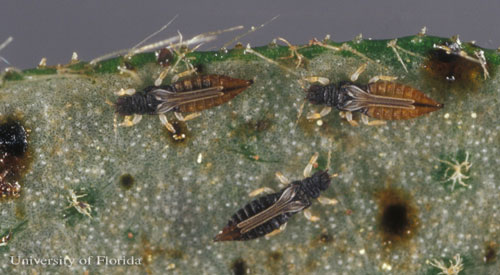Adaptation
he
Heliothrips Haemorrhoidalis (Bouche) has number of adaptations.
The most important adaptation of this organism is its mouth.
The mouth of the greenhouse thrip has developed a vestigial
mandible on the right side.
Other parts of the mouth have elongated into styles for jobs
such as piercing plant tissue, sucking up plant sap, and sucking the
blood out of mites and other small insects (Dunn 1996).
This adaptation has allowed the
Heliothrips Haemorrhoidalis (Bouche) to be able to eat what they
live around. It also allows
the thrip to saw into plant tissue to lay their eggs as well as
getting to and eating the eggs or larvae of various types of other insects (Wigglesworth 1964).
In addition to that greenhouse thrips have adapted their metabolism.
The thrip’s metabolism is paurmetabolous but has been
modified to resemble holometabolism (Arnett 1985).
This allows the thrip to seemingly go through complete
metamorphosis. The greenhouse thrip utilizes its wings and
legs for locomotion. Mostly the Heliothrip Haemorrhoidalis
uses its legs to move. The wings of this organism are not
particularly strong so it cannot fly a very large distance (Morse
and Hoddle 2006).
insects (Wigglesworth 1964).
In addition to that greenhouse thrips have adapted their metabolism.
The thrip’s metabolism is paurmetabolous but has been
modified to resemble holometabolism (Arnett 1985).
This allows the thrip to seemingly go through complete
metamorphosis. The greenhouse thrip utilizes its wings and
legs for locomotion. Mostly the Heliothrip Haemorrhoidalis
uses its legs to move. The wings of this organism are not
particularly strong so it cannot fly a very large distance (Morse
and Hoddle 2006).
